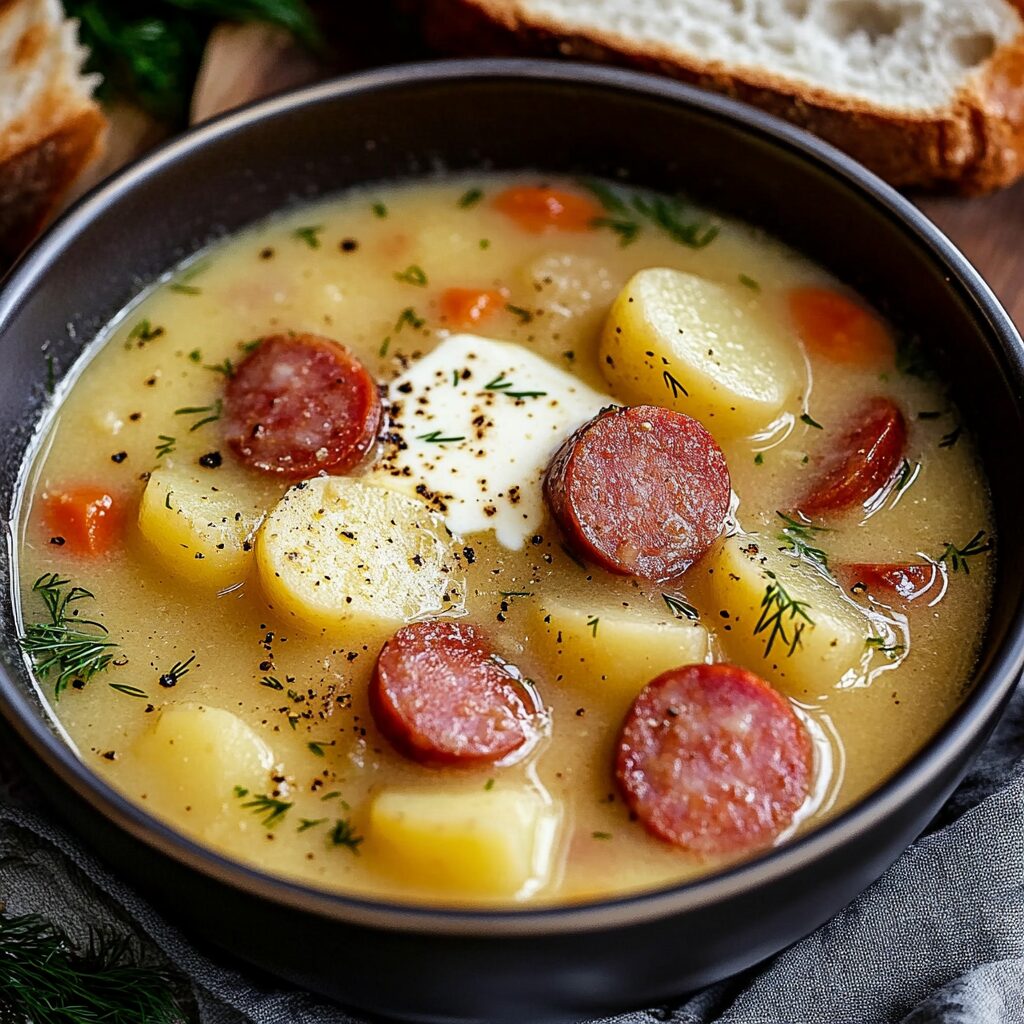Kartoflanka, or Polish Potato Soup, is a beloved comfort food that showcases the simplicity and heartiness of Polish cuisine. This rustic soup combines tender potatoes, smoky kielbasa, and aromatic vegetables, simmered to perfection in a flavorful broth. The addition of sour cream adds a creamy richness, while fresh dill provides a burst of freshness. Traditionally served with rye bread, Kartoflanka is a satisfying meal that brings warmth and nostalgia to the table.
Whether you’re seeking a cozy dinner for a chilly evening or a dish that evokes the flavors of Poland, this soup delivers both comfort and taste. Its straightforward preparation and wholesome ingredients make it an ideal choice for family meals or gatherings. With each spoonful, you’ll experience the essence of Polish home cooking—a dish that’s both nourishing and delicious.
Full Recipe
Ingredients:
-
6 medium potatoes, peeled and diced
-
2 smoked kielbasa sausages, sliced
-
1 small onion, diced
-
2 carrots, sliced
-
4 cups chicken or vegetable broth
-
1 cup sour cream
-
2 tbsp butter
-
1 tsp marjoram
-
Salt and pepper to taste
-
Fresh dill for garnish
Directions:
-
In a large pot, melt butter over medium heat. Add kielbasa slices and cook until browned. Remove and set aside.
-
Add diced onion and sliced carrots to the pot, cooking for 5–7 minutes until softened.
-
Stir in diced potatoes, broth, marjoram, salt, and pepper. Bring to a boil, then reduce heat and simmer for 25 minutes.
-
Stir in sour cream and return the kielbasa to the pot. Simmer for an additional 5 minutes.
-
Garnish with fresh dill and serve warm with rye bread.
Prep Time: 15 minutes
Cooking Time: 45 minutes
Total Time: 1 hour
Kcal: Approximately 350 kcal per serving
Servings: 6 servings
A Classic Comfort Food from Poland
Polish Potato Soup, also known as Kartoflanka, is one of those timeless dishes that define the heart and soul of Polish cuisine. Rooted deeply in the traditions of Eastern Europe, this humble yet hearty soup is a staple in Polish households—particularly during the colder months. Its comforting warmth, creamy texture, and smoky undertones make it more than just a meal; it’s an experience passed down through generations.
Unlike many modern soups that rely heavily on elaborate ingredients or complex cooking techniques, Kartoflanka is celebrated for its simplicity. It relies on fresh, accessible ingredients and a slow-cooking process that allows all the flavors to meld beautifully. It’s a soup that brings families together, often served as a main course with a side of rustic rye bread or crusty rolls.
The Cultural Significance of Kartoflanka
In Poland, food is not just about sustenance—it’s about family, tradition, and history. Kartoflanka embodies all of these values. It’s often one of the first dishes that Polish children learn to cook with their grandmothers. The act of peeling potatoes, stirring the pot, and adding a touch of sour cream at the end becomes a rite of passage in many households.
Historically, the soup gained popularity as an affordable and filling dish that could feed large families without breaking the bank. During difficult times—such as war or economic hardship—Kartoflanka was a reliable and nourishing meal. Its ingredients are pantry staples, and variations of the soup could be adapted based on what was available, making it highly practical and deeply rooted in the realities of everyday life in Poland.
Regional Variations and Family Twists
Though the core components of Kartoflanka remain the same—potatoes, broth, onions, carrots, and smoked kielbasa—each region and household has its unique twist. In some parts of Poland, mushrooms are added to enhance umami depth, especially during Christmas when meat is omitted for religious reasons. Other versions may include leeks or celery for a more aromatic base, or bay leaves for a subtle earthiness.
Some families also add a splash of vinegar or a dash of horseradish to sharpen the flavor, while others prefer a thicker consistency achieved by partially mashing the potatoes. The sour cream stirred in at the end is nearly non-negotiable, giving the soup its iconic creamy texture and slightly tangy finish. Garnishing with fresh dill not only brightens the soup but ties it closely to traditional Polish flavor profiles.
The Role of Smoked Kielbasa
One of the defining features of this version of Polish Potato Soup is the inclusion of kielbasa, a traditional smoked Polish sausage. Kielbasa imparts a rich, savory, smoky flavor that transforms a simple vegetable soup into a full-bodied, satisfying dish. Its inclusion elevates Kartoflanka from a side dish or starter into a complete meal.
In some vegetarian adaptations, the kielbasa is left out and replaced with additional root vegetables or mushrooms. However, for the most authentic experience, a good-quality smoked kielbasa is highly recommended. Its fat renders into the broth as it cooks, lending depth and complexity that are hard to replicate with substitutes.
Why This Soup is Still Relevant Today
In an age where fast food and processed meals dominate many people’s diets, dishes like Kartoflanka stand as a reminder of the beauty in slow cooking and whole ingredients. Its nutritional value—being rich in fiber, vitamins, and proteins—makes it a smart choice for anyone seeking a balanced and wholesome meal.
Moreover, the soup is naturally gluten-free and can be easily adjusted to meet other dietary needs, such as vegetarian or dairy-free preferences. It’s a great example of how traditional meals can adapt to modern health trends without losing their essence.
Perfect Occasions for Serving Kartoflanka
Kartoflanka is versatile enough to be enjoyed in many settings. It makes for a cozy family dinner on a winter evening, a hearty lunch on a busy weekday, or a comforting dish during holiday gatherings. Because it’s relatively easy to prepare in large quantities, it also works well for community events, potlucks, and cultural festivals.
The soup can be prepared ahead of time and actually improves in flavor after resting for a day in the fridge, making it ideal for meal prepping. Paired with fresh bread and maybe a side of pickles or sauerkraut, it becomes a well-rounded Polish meal that’s both satisfying and nostalgic.
Cooking Tips for a Perfect Bowl
To bring out the best in Kartoflanka, consider a few key cooking tips. First, don’t rush the sautéing of the kielbasa—this step develops a crucial layer of flavor that carries through the entire dish. Use high-quality broth (homemade if possible), and take the time to dice the vegetables uniformly for even cooking.
When adding sour cream, temper it with a bit of hot broth before stirring it into the pot to prevent curdling. And finally, use fresh dill rather than dried—it makes a noticeable difference in both flavor and presentation.
How to Store and Reheat
Kartoflanka stores exceptionally well. Once cooled, it can be kept in an airtight container in the refrigerator for up to 4 days. The flavors tend to deepen with time, making leftovers even more delicious. It can also be frozen for up to 2 months, though it’s best to add fresh sour cream and dill after reheating for a fresher taste.
When reheating, use a low simmer to avoid breaking the texture, especially if sour cream has already been added. Stir occasionally and add a splash of broth or water if the soup has thickened too much.
A Soup That Tells a Story
Kartoflanka is more than a recipe—it’s a storytelling vessel. With each spoonful, you taste generations of resilience, love, and tradition. It’s the kind of dish that reminds you of home, even if you’re miles away. Whether you’re of Polish heritage or simply a lover of global cuisine, this soup welcomes you with open arms and a warm bowl.
Conclusion
Polish Potato Soup (Kartoflanka) stands as a symbol of comfort, resourcefulness, and culinary heritage. Its simple ingredients and rich flavor offer an experience that transcends time and borders. Whether you’re discovering it for the first time or revisiting a family favorite, this soup offers warmth not just to the body but to the soul.
As more people turn to traditional dishes in search of meaning and nourishment, Kartoflanka shines as an ideal example of how food can connect us to our roots, our families, and our cultures. So next time you need a little comfort in a bowl, reach for potatoes, kielbasa, and dill—and make yourself a pot of this timeless Polish classic.





